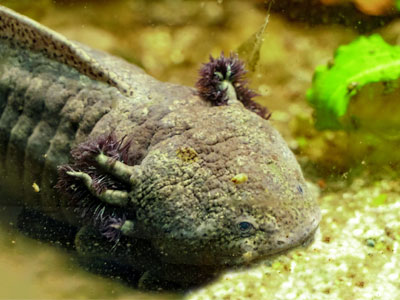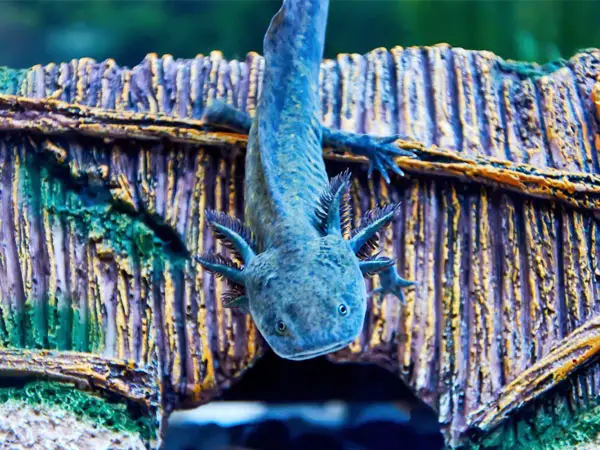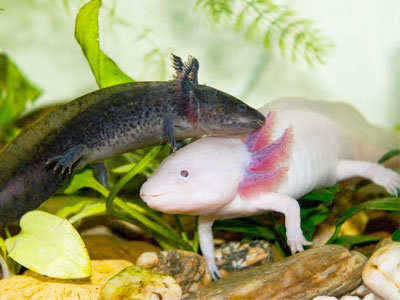
Axolotls have amazing regeneration capabilities that allow them to regrow limbs, gills, and regenerate organ parts and even their spinal cords.
Unfortunately, they’re not immune to diseases and just like other aquatic animals, they’re prone to stress-induced diseases as well as a host of other illnesses caused by improper keeping conditions and infections.
Axolotls have a lifespan of 10-15 years, which is a relatively long time in the realm of home aquaria. Raising axolotls is not easy and it’s not for everyone, especially when it comes to raising healthy axolotls.
If you want to know more about the diseases and illnesses that affect axolotls, as well as current remedies for these, I encourage you to read this guide on axolotl diseases, parasites and remedies.
Here are the most common axolotl diseases and remedies:
1. Stress
Stress isn’t a disease in itself, but it ranks as the number one cause of diseases among axolotls. There are many things that can stress axolotls, chief among them is bad water parameters.
To recap, axolotls enjoy stable water parameters with temperatures in the range of 59-73 Fahrenheit (15 and 23 degrees Celsius), water pH between 6.5 to 8.0, and slightly hard water conditions.
Other than bad water parameters, an overcrowded tank is another issue that can and will put a lot of stress on axolotls, especially that axolotls are known to snap down on each other’s limbs and gills. Not to mention the cannibalistic traits exhibited by juvenile axolotls.
While axolotls can regenerate lost limbs, in case of an injury, the chances of infection and illness are higher, especially in an overcrowded tank.
Besides aggression from their own kind, axolotls don’t do well in community aquariums either, especially when it comes to aggressive tank mates.
Fish can nip at the sensitive gills and limbs of axolotls, and it’s best for axolotls to be kept away from any community aquarium.
Strong water current is another thing to be mindful of when keeping axolotls. Water flow should be very gentle since strong currents are a stress trigger in axolotls.
Axolotls are also averse to bright lights and don’t require any artificial lighting for their tanks. If you must set up lights because of the plants that you keep in the tank, I strongly advise setting up hiding spaces and covered areas where your axolotl can take refuge.
2. Ammonia Poisoning
Water quality is crucial when it comes to your axolotl’s health. Axolotls don’t tolerate ammonia spikes; therefore, you must practice regular water changes and monitor toxin levels.
If left unchecked, ammonia and nitrite build-up resulting from improper tank maintenance can become fatal to your axolotl in a matter of days.
Symptoms
- Loss of appetite
- Lethargy
- Curled and whitened gills
- Loss of gills
- Red patches on skin
- Bleeding
Treatment
Ammonia levels in the axolotl tank should be at 0 ppm. Testing the water for toxins and pH levels should be carried out regularly. It’s crucial to cycle the tank before adding any axolotls.
If you detect ammonia in the water, performing a 50% water change and adjusting the pH levels in the tank is the first things you should do. Next, refrain from feeding or limit feeding until levels are back to normal.
3. Hyperthermia
Axolotls enjoy colder temperature water and keeping their water cold during summer heats can be difficult, however, it’s necessary to avoid hyperthermia.
Hyperthermia is the opposite of hypothermia. Indeed, your axolotl can easily get overheated if you keep it at high temperatures.
Temperatures above 73 Fahrenheit (23 C) are highly problematic — oxygen concentrations in the tank decrease and bacteria can multiply, leading to infections.
Symptoms
- Uncontrollable floating
- Loss of appetite
- Fluid build-up in the abdomen
Treatment
Bacterial infections can be prevented with antibiotic therapy, however, reducing the temperature in the tank is just as crucial. You may even place the axolotl in a dish and place it into the refrigerator for quick relief.
Using frozen water bottles can also help bring down the water temperature, even so, if you live in a climate, where temperatures are high during the summer or all year round, I advise you to invest in a tank cooling system to avoid hyperthermia.
4. Gastric and Intestinal Foreign Bodies
The reason why guides on raising axolotls recommend avoiding gravel as a substrate for axolotl tank is impaction.
Because of the way axolotls feed (by sucking in water and any food that comes with it), there is a high chance of them ingesting sizeable pieces of gravel that cannot be digested and that can cause bowel obstruction.
Sand or bare-bottom tanks are preferable to gravel, but even sand can be problematic for juvenile axolotls.
Swallowing smaller fish that barely fit their mouths can also cause impaction. In short, axolotls are prone to gastric and intestinal issues caused by food that is too large for them.
Symptoms
- Bloating, constipation, and floating in the tank
- Frantic swimming
- Loss of appetite
- No waste production
Treatment
The axolotl may be able to expel the foreign object that’s causing the issue. Fridging can aid the process of expelling the indigestible foreign body from the GI tract.
If the object cannot be regurgitated or expelled, the axolotl will be put under anesthesia and the object will be removed surgically, with the help of alligator forceps.
5. Parasites
Axolotls fed with live foods are susceptible to infections caused by parasites carried by live foods.
Being careful about where you get their live foods from or creating your own live cultures can significantly reduce the incidence of parasitic infections.
Parasites such as ciliates, Opalina, Hexamita as well as protozoa such as Costia and Trichodina can all spell trouble for your axies.
Symptoms
- Refusal to eat
- Mucus secretion
Treatment
If you’ve ruled out all other diseases (e.g. obstruction, constipation) and tank water conditions are optimal, you’ll need to administer anti-parasitic medicine into the tank.
Enteric protozoans like Hexamita can be treated by adding metronidazole to food at 5 mg/g concentration.
Parasites that latch onto the skin can be treated with salt baths (2.5% solution), formalin baths (0.025-0.050 ml/L), or magnesium sulfate concentrations.
6. Bacterial Infection
Axolotls housed in poor tank conditions often suffer from completely preventable bacterial infections. Whether it’s because of a lack of proper tank maintenance or because of infected live foods or unsterile plants, bacterial infections can be dangerous for your axolotls if the disease is not caught and treated on time.
Symptoms
- Reduced appetite
- Red patches on body
- Fin and tail rot
- Ulcers
- Scale shedding
- Bleeding in the anal and gill area
Treatment
Bacterial infections can be treated with antibiotics (sulfonamide, florenicol, and chloramphenicol) via injections administered by your vet.
Some infections caused by Aeromonas hydrophila can be managed with 2% calcium hypochlorite solution or 1% sodium hypochlorite solution.
As always, the best cure for bacterial infections in axolotls is prevention by way of keeping water parameters within the optimal range, performing regular water changes and being circumspect about the live foods and plants or utensils you introduce into the aquarium.
7. Fungus
High water temperature along with poor water conditions are the most common triggers for fungal infections in axolotls.
Symptoms
- White, fuzzy patches on body
Treatment
Fungal infections are treated with salt baths. Infected axolotls need to be quarantined and treated with salt baths every day until the issue is solved. Water changes are required daily during quarantine.
For salt baths, you’ll need to use non-iodized aquarium salt or sea salt. Salt should be added in 2-3 teaspoons per litre concentrations.
Each salt bath should take 10-15 minutes and you may need to do daily salt baths for 1-2 weeks until the problem goes away.
8. Saprolegnia
This fungal infection targets axolotls with a compromised immune system. Bad water conditions, stress and injuries can all trigger saprolegnia.
This fungus targets internal tissues and it’s found in most water sources becoming dangerous when the immune system of aquatic organisms is weakened.
Symptoms
- Grey, white or tan to brown, fuzzy growths on head or gills
- Loss of gill stalks
- Death
Treatment
Addressing the root cause (bad water conditions or other stress triggers) is crucial in eradicating saprolegnia.
Using potassium permanganate and doing salt baths is also essential in getting rid of this fungus.
9. Tumor
Axolotls can develop tumors, which are usually benign and can be removed by a vet if it causes problems or affects the life quality of the axolotl. Tumors usually involve the pigment cells.
Symptoms
- Unusual growths on the head, gills or other parts of the body
Treatment
If bening and it doesn’t interfere with the normal life of your axolotl, there is no need for surgical removal.
How to Dispose of Dead Axolotl?
If you find a dead axolotl in a tank, where you keep other axolotls too, you should remove it immediately and carry out a water change to avoid other axolotls getting sick.
I also recommend to reduce the number of axolotls you keep in a single tank or get a large enough tank that can comfortably accommodate them. Ideally, you shouldn’t have multiple axolotls residing in the same aquarium.
Next, you should dispose of the axolotl by burying it deep in the ground. If you have dogs or there are other animals known to dig up food in the garden, best if you avoid this approach.
Another method is to place the axolotl into a plastic zip lock back and put it into the garbage. Under no circumstances should you throw the body of the axolotl into a lake nor should you flush it down the toilet because you risk contaminating the water supply.
Can Axolotls Have Ich / Ick?
If you’ve kept fish before, you’ve probably come across ich disease, which is common in tropical aquariums.
Although it’s easy to mistake ich for a fungal infection, it’s actually caused by a parasite. Luckily, amphibians very rarely if ever get ich, so it’s unlikely that your axolotl can be affected. Still, if your aquarium has ich disease, it’s best to remove all residents until you can treat it.
Can Axolotls Have Camallanus Worms?
A common intestinal parasite that commonly only affects tropical fish, it’s better to be safe than sorry, and avoid adding anything to the aquarium that might carry it.
That includes live foods, unsterilized plants and decorations.
Can Axolotls Have Cancer?
The axolotl is one of the most scientifically studied salamanders partly owing to its regenerative capabilities and partly to its impressively large genome, which is 10 times larger than the human genome.
Axolotl can regenerate their legs, tails, gills, parts of major organs, spinal cords and even parts of their brains.
Turns out this isn’t the only superpower of axolotls, they also have a high resistance to cancer.
Scientists have used extract from axolotl oocytes, which was found to reactivate cancer suppressing genes, managing to take control of cancer cells.
This finding, along with the ability of these aquatic salamanders to regenerate can have a significant impact on human cancer research and tissue regeneration.
Tips to Prevent Diseases In Your Axolotl Aquarium
When it comes to the best remedies for axolotl diseases, I always go out of my way to argue for prevention as the best remedy.
Indeed, prevention may require that you’re always mindful of the requirements of your axolotl and may require you to spend extra time on certain maintenance tasks, but be that as it may, in the end it’s always better to avoid diseases altogether than later deal with the consequences.
Here are some easy to follow tips to help you avoid diseases and keep your axolotl healthy:
Keep one eye on water parameters
Make sure you are clear on the water parameters required by axolotls and you keep their water in their preferred range.
Stable water parameters are also crucial since fluctuations aren’t tolerated well by axolotls. Sudden changes will stress them out, opening the way for diseases.
Perform regular water changes
Performing the nitrogen cycle before adding axolotls to the tank and weekly water changes coupled with a good filter system that’s adequate for axolotls (gentle water current) are part of a good tank maintenance regimen that will minimize the risk of diseases.
Don’t overfeed
Overfeeding can cause constipation, bloating and obstruction, but can also increase waste production, which in turn elevates the toxicity of the water.
Because axolotls can ingest small pebbles and gravel, you should avoid these for their substrate and add sand once they’re large enough that sand doesn’t pose a risk for them
Don’t overcrowd
I’m not a fan of keeping multiple axolotls in the same aquarium. I’m also not a fan of keeping axolotls with other aquatic creatures. If you do decide to add tank mates, make sure they all have plenty of space to stay out of each other’s sight.
Overcrowding nurtures aggression, which can lead to injuries, which in turn can lead to deadly infections.
Don’t feed your axolotls with live foods from an unknown source
Live foods can be especially dangerous as they can carry parasites, which can infect your axolotls. Whenever possible, make your own live cultures or source them from reputable vendors. If reliable sources of live foods are not available, you can use freeze-dried alternatives, which are disease-free.
Anything you add to the aquarium should be cleaned and sterilized
Not only live foods can be dangerous, but also plants and decorations too. Sterilize these before adding them to the aquarium to remove any parasites.
Don’t use chlorinated water for water changes
If you’re using tap water, make sure it’s chlorine- and chloramine-free. Axolotls are sensitive to chemicals, therefore, use water conditioners to remove harmful substances.
Create a stress-free environment
Strong water currents, strong lights, aggressive tank mates are all stress triggers that must be eliminated.
Don’t handle your axolotl unless you must
Axolotls should not be petted or handled, or taken out of the water unnecessarily. They don’t have any need to interact with their owners and since they’re quite sensitive, it’s best to minimize your handling of them.
Monitor axolotl for changes in behavior & signs of disease
Noticing early signs of diseases can help you administer treatment to your axolotl as soon as possible and prevent more serious problems down the line.
Familiarize yourself with the symptoms of the different diseases, look at pictures and videos online to see how different diseases manifest.
Conclusion
The diseases I discussed in this article are the most common among axolotls. Many of these diseases can be prevented by simply being more careful and offering your axolotls ideal tank conditions.
As I mentioned, axolotls have amazing regenerative abilities, but they’re not immune to all diseases, therefore, you must also do your part on making sure they don’t get infections and they aren’t stressed out.
You can take this guide as a primer on axolotl diseases and remedies, but I encourage you to make your own research as well by visiting specialty forums on axolotls.





I have an albino axolotl. I have had him for 3 years. Lately his mouth does not close and face looks swollen. He is not eating and not surfacing for air. I have been lifting him with a net to get him to take a breath. This has been going on for about 7 days. I do not find anything about the open mouth issue. Any ideas would be greatly appreciated.
I assume that something is stuck in your axolotl’s throat, which causes your axolotl to keep its mouth open all the time. What substrate do you have? Impaction is a common problem with axolotls kept in tanks with gravel substrate.
I use sand as a substrate. There is nothing in his throat. He did finally pass. I took him to my vet and he could not figure out what happened. Thank you replying.
Axolotls can have camallanus worms. The answer is yes. Not sure why you’re dodging a very direct question.
My axolotl stopped eating about a week and a half, nothing seems stuck in his mouth but does act weird sometimes like opens and shuts his mouth like his choking but then stops and calma down but the big noticeable thing is its butt is really swollen. Any opinion of what could be the problem?
I think that your axolotl swallowed something and has impaction. You should consult a vet as soon as possible. What substrate do you use in the tank?